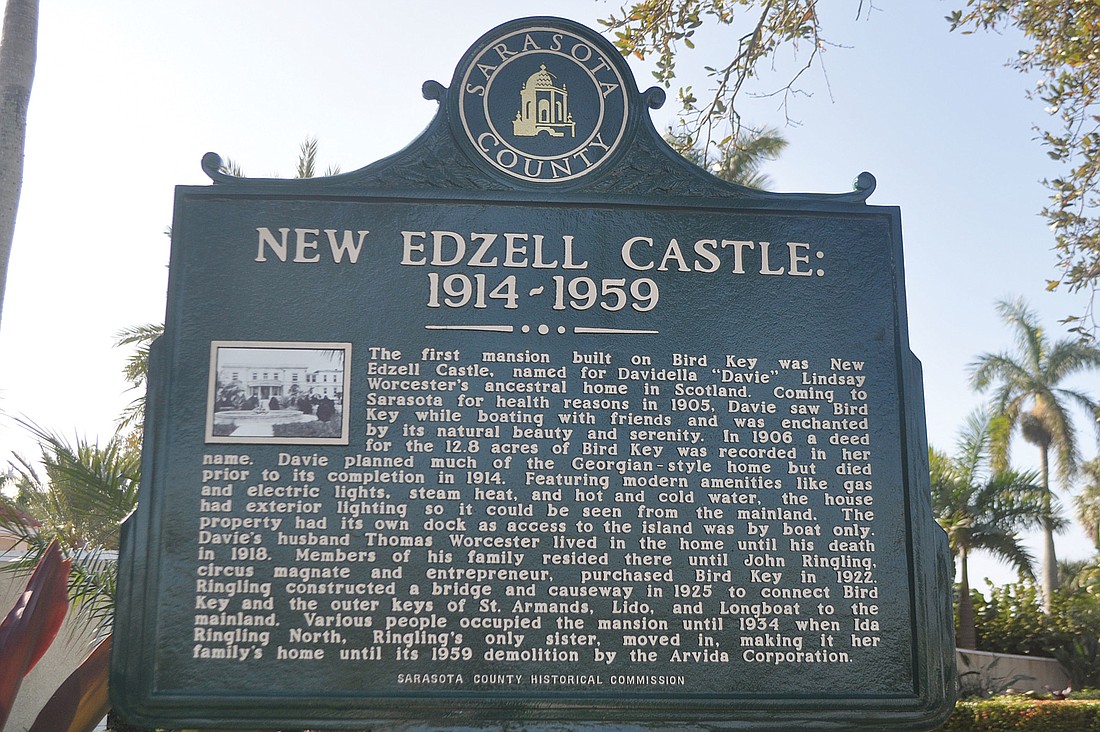- April 19, 2024
-
-
Loading

Loading

“Today is the culmination of a tremendous effort of county commissioners, historians and residents,” Russ Gutmann, chairman of the Sarasota County Historical Commission, told the roughly three-dozen people who braved a chilly morning Saturday, Jan. 5, to witness the unveiling of Bird Key’s historical marker at its entrance on John Ringling Boulevard.
The application, review and installation process to get a historical marker takes years to complete, Gutmann explained.
The fact that Bird Key residents possessed the tenacity to get a marker came as no surprise to Sarasota Mayor Suzanne Atwell, who moved to the Key 14 years ago and spoke at the ceremony.
“I quickly learned how seriously the community cares about the beauty of Bird Key,” she said. “Now we have that commitment enshrined for all the walkers, joggers and bikers to see when they cross the bridge.”
Originally, Bird Key was 12.8 acres of rock, which caught the eye of Davidella “Davie” Lindsay Worcester while she was boating with friends. Worcester purchased the land in 1906 and drew up plans for a Georgian-style mansion, New Edzell Castle, named for her ancestral home in Scotland. Worcester died in 1912, two years shy of the home’s completion, but her relatives, followed by John Ringling’s, occupied New Edzell Castle until its demolition in 1959.
During the latter half of the 20th century, Bird Key grew exponentially.
In 1951, Ringling’s nephew, John Ringling North, purchased 280 submerged acres from the state to expand Bird Key. Eights year later, the Arvida Corporation purchased the property (and then some), dredging and filling the submerged land to enlarge the island to its present size of approximately 300 acres. Today, Bird Key has 511 residential lots.
From a rocky dream to a luxurious haven
“Bird Key began as a dream, when a young woman spied beauty in the 13 acres of rock while boating. It is here today because of the nexus of her dream and the ambition of a development company,” said Eileen Normile, president of the Bird Key Improvement Association.
Here’s an overview of the island’s history.
1905: Davie Worcester spots a rocky island while boating.
1906: Worcester purchases the 12.8 acre-island.
1914: New Edzell Castle, Bird Key’s first mansion, is completed.
1922: Business associates John Ringling and Owen Burns purchase Bird Key from Worcester’s heirs.
1925: Ringling constructs a bridge and causeway to connect Bird Key and the outer keys of St. Armands, Lido and Longboat to the mainland.
1934: Ida Ringling North, Ringling’s only sister, moves in to New Edzell Castle.
1936: Following Ringling’s death, Ida Ringling North and her son, John Ringling North, become administrators of the Ringling estate, which includes Bird Key.
1951: John Ringling North forms the Bird Key Corporation and acquires 280 submerged acres from the state to expand the island.
1959: The Arvida Corporation purchases 2,000 acres of Ringling property, which includes Bird Key. With the intent of creating “a luxurious island residential haven,” the company dredges and fills the submerged property and starts construction of the island’s infrastructure.
1960: In place of New Edzell Castle, torn down in 1959, Arvida builds the Bird Key Yacht Club.
1964: Bird Key is connected to the city water system.
1967: Arvida transfers the Bird Key Yacht Club to the island’s residents.
2013: Bird Key receives a historical marker, located at its entrance on John Ringling Boulevard.